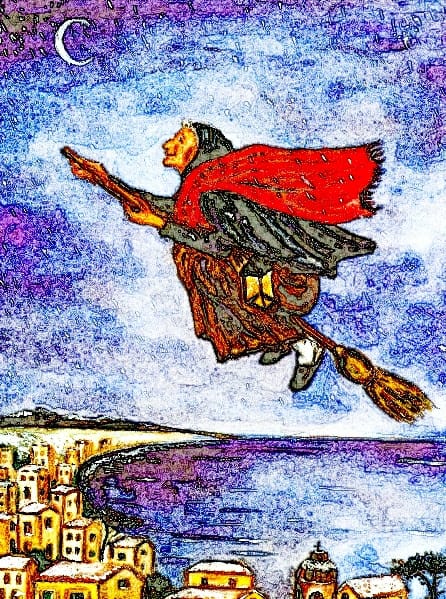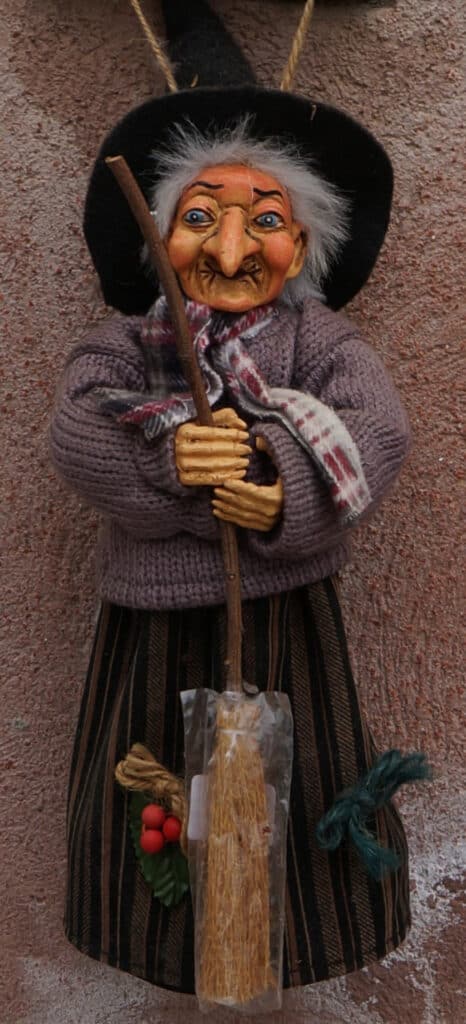

by Stefania Puxeddu Clegg
Cari lettori,
As we approach this time of the year again, a question arises: how do we (educators, parents) introduce Befana — this folkloristic, kind, old female character — in very simple words to school children, and how do we justify her presence shortly after Santa’s visit?

The character of Befana most likely originated from Northeastern Europe (Belarus, perhaps), possibly evolved, and, like Mary Poppins, followed the southward winds and landed in Italy at some point. How and why do we have her deliver even more gifts on the 6th of January (as if whatever was received on the 25th was not enough) was never really clear to me. And why on earth does she have to uncomfortably ride a broom rather than a camel (like the Wise Kings) or use an umbrella (like Mary Poppins)? Was she perhaps the leading lady, a trendsetter of the equal opportunity movement at its very beginning?
Some of us still remember the fascinating concept of “Befana aziendale” (the employer’s Befana), an opportunity given by employers to their employees to purchase toys and Christmas gifts for their families during the economic boom in Italy.
Furthermore, and just to clarify, once and for all: Befana was definitely not a witch, she didn’t wear a pointed hat (despite what you see on the web), and had a foulard tied on her head. Her gown was well worn with patches all over, and surely her shoes were broken! She was most likely dressed in black or dark colours like many elderly women from southern Italy or the islands, and like those women, she was poor and did humble jobs serving her community, perhaps cleaning chimneys with her broom and distributing charcoal.
I once again find some similarities between Befana and another character from Disney’s original Mary Poppins: the old lady at the steps of St Paul’s cathedral, feeding the birds (Tuppence the Birds is the song — tuppence = two pence, due soldini per nutrire gli uccellini, in Italian translated with ‘bastan due penny’).
Italian Befana did not feed birds, and New York Befanas should not even think about it, given the current rodent emergency. Italian Befana did not deliver real charcoal, either, although sometimes she would leave a chunk or two of her stuff alongside a stocking full of little gifts for the children: candies, licorice, or chocolates but also stationery and tiny little toys and “rompicapo.” All of the children, of course, would receive her gifts and none of them would eat her fake charcoal, despite its sweetness, in the end.
Many are the rhymes dedicated to this popular character. There are possibly as many as 30 different versions of the following four lines:
La Befana vien di notte
con le scarpe tutte rotte
con le toppe alla sottana:
Viva, viva la Befana!
La Befana comes at night
wearing old broken shoes, and tight,
she has a dark patched-up gown
long live Befana of great renown!
(the above translation is mine)
So there.
Viva la Befana, Buona Befana a tutti!

Stefania Puxeddu Clegg is a native Italian who has lived, studied and worked in different English speaking countries. Currently living in the Big Apple, she loves children’s books and drawing. Stefania has studied English language and literature, food chains and sustainability, and is passionate about multilingualism and multiculturalism. Her family is spread across three continents.